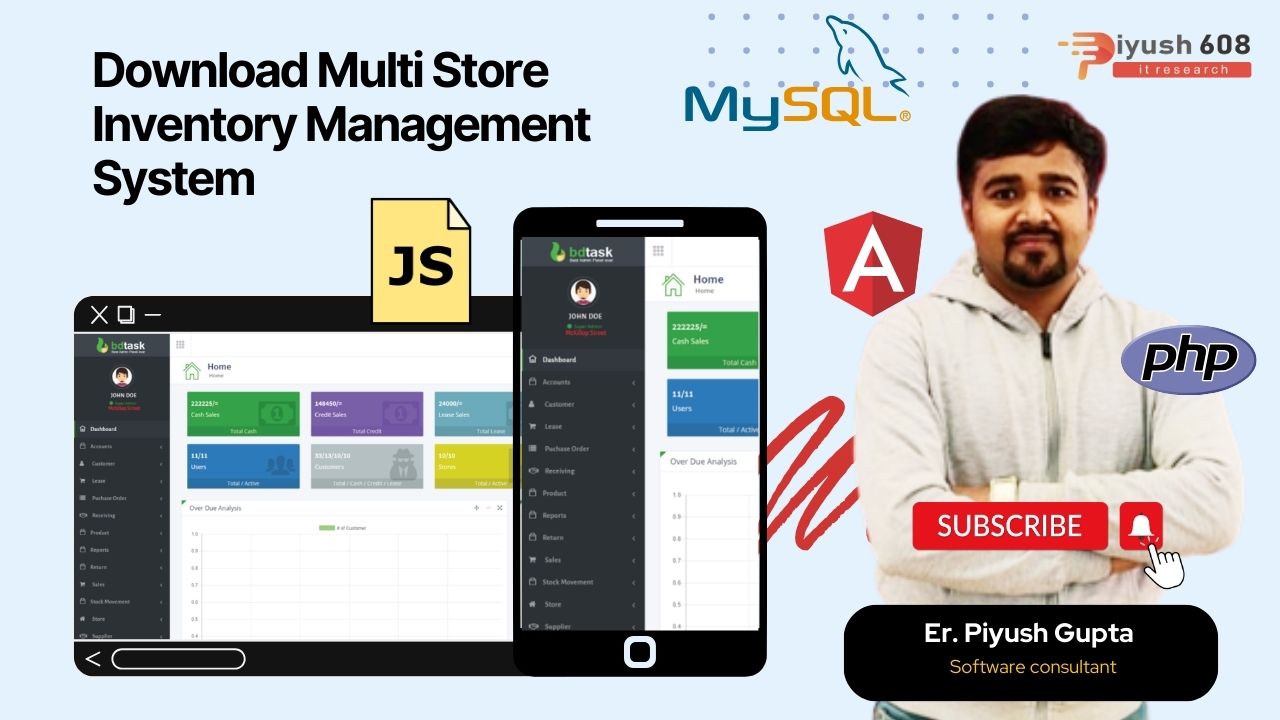
Developing a complete multi-store inventory management system in PHP and MySQL is a significant project that involves multiple functionalities such as user management, store management, inventory management, sales management, and reporting. Due to the complexity and length of such a system, I’ll provide a basic outline and code snippets for essential features:
- Database Design:
- Create a MySQL database with tables for users, stores, products, inventory, sales, etc. Each store can have its own set of products and inventory.
- User Management:
- Implement user authentication and authorization (login, logout, registration, user roles).
- Store Management:
- Allow users to manage multiple stores (add, edit, delete stores).
- Product Management:
- Enable users to add, edit, and delete products for each store.
- Each product should have attributes like name, description, price, quantity, etc.
- Inventory Management:
- Track inventory for each product in each store (stock in, stock out, adjustments).
- Implement functionalities to manage stock levels and receive alerts for low stock.
- Sales Management:
- Record sales transactions for each store.
- Implement functionalities for creating sales orders, generating invoices, and processing payments.
- Reporting:
- Generate reports such as inventory levels, sales reports, profit/loss statements, etc.
- User Interface:
- Design a user-friendly interface for users to interact with the system.
- Use HTML, CSS, and JavaScript for front-end development.
Features
- Super Admin Dashboard
- Store Admin Dashboard
- Pricing User Dashboard
- Purchase User Dashboard
- Store User Dashboard
- Accounts
- Chart of Accounts
- Debit Voucher
- Credit Voucher
- Contra Voucher
- Journal Voucher
- Voucher Approval
- Account Reports
- Voucher Reports
- Cash Book
- Bank Book
- General Ledger
- Trial Balance
- Profit Loss
- Cash Flow
- COA Print
- Customer
- Add
- List
- Lease
- Add
- List
- Purchase Order
- Add
- List
- Receive Order
- Receiving
- Credit Received
- Recovery Received
- Customer Overdue Recovery
- Product
- Category
- Model
- Brand
- Unit of Measurement
- Add Product
- Product List
- Reports
- Lease and Recovery Report
- Stock Report
- Return
- Add
- Sales Return List
- Purchase Return List
- Sales
- Add
- Cash Sale List
- Credit Sale List
- Lease Sale List
- Stock Movement
- Store
- Add Store
- Store List
- Supplier
- Users
- Role Permission
- Language
- Backup
- Application Setting
- Message
Server Requirements
- Apache or IIS or Nginx
- PHP version 5.3 or greater (recommended: PHP 5.4 or greater)
- MySQL version 5.0 or greater (recommended: MySQL 5.5 or greater)
- OpenSSL PHP Extension
- PDO PHP Extension
- MCrypt PHP Extension
Multi Store Inventory Management System Installation
These are the steps on how to install Online Multi Store Inventory Management System:
- Please Extract the M-Store.zip folder. Then you will get M-Store.zip and Documentation Folder, First read the documention.
- Now just Upload the M-Store.zip file to your server using cPanel or FTP.
- Extract the M-Store.zip file
- Now you just access into the your uploaded folder and then move all folders and files (EX: application, assets,index.php,install and system folders) one step up to public_html directory or can create comment folder and then you can keep it at the folder . Note: Keep in mind about .htaccess file is moved correctly otherwise you cannot access into the admin panel.
- Note that: the instruction will be applicable for all other system.
- Now, Browse your application http://yourdomain.com/install Installer first step showing the directory and server requirements. If all requirements successfully meet then click on Next button
- Folder structure of Installer
- Delete the .env file if exists in install/flag/ directory . We added default empty flag…please you check everytime before installing.
- Put your application database into sql directory and rename it as install.sql . we already added here default database
- *Enter your database name, username, password, host name and click on Next button
- Just wait 10 seconds to complete the installation process
- Installation successfully done…
- Now, Click on Click to launch your application button to access your application
- Please go to your domain name http://yourdomain.com/login
- User name: admin@example.com | Password: 12345 . After login please change your user name and password.




 +91 7905834592
+91 7905834592
 Enquiry Now
Enquiry Now
 piyushmnm@gmail.com
piyushmnm@gmail.com
 piyush.gupta384
piyush.gupta384
Reviews
There are no reviews yet. Be the first one to write one.